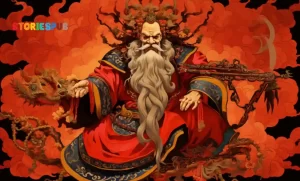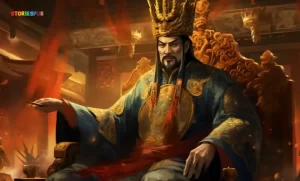The Story of the Eight Trigrams and the I Ching

Fu Xi was a mythical figure who lived thousands of years ago in ancient China. He was said to have been one of the earliest rulers of China, and was revered as a wise and learned man who had deep understanding of the natural world and the forces that governed it.
One of the most famous things that Fu Xi was said to have created were the Eight Trigrams. These symbols were meant to represent the various aspects of nature and the universe, and were based on the observation of patterns in the natural world.
Each trigram consisted of three lines, either solid or broken, that could be combined in different ways to create a total of 64 different hexagrams. The trigrams were meant to represent the fundamental forces of nature, such as water, fire, wind, earth, and others, and each trigram had its own unique symbolism and meaning.
For example, the trigram for water consisted of three broken lines, and was associated with fluidity, adaptability, and change. The trigram for fire consisted of three solid lines, and was associated with passion, energy, and creativity. Other trigrams represented things like heaven, earth, thunder, and mountain, each with its own unique characteristics and symbolism.
According to legend, Fu Xi not only created the Eight Trigrams, but also wrote a book called the I Ching, which was based on the trigrams and their meanings. The I Ching, also known as the Book of Changes, was a work of philosophy and wisdom that was meant to help people understand the nature of the universe and their place in it.
The I Ching was often used for divination, but it also contained many teachings about morality, ethics, and the human condition. It was believed that by studying the I Ching and consulting it for guidance, people could gain insight into the patterns and forces at work in the natural world, and make better decisions about their lives and relationships.
Legend has it that Fu Xi received divine inspiration to create the Eight Trigrams and the I Ching. One day, he was standing by the Yellow River when he saw a dragon emerge from the water. The dragon then transformed into a horse, which showed him the patterns of the trigrams and taught him how to use them to understand the natural world.
Fu Xi was said to have written the I Ching based on this divine inspiration, and it quickly became an important part of Chinese culture and philosophy. It was studied by scholars and philosophers, used by emperors and other leaders to make important decisions, and consulted by ordinary people to gain insight into their lives and relationships.
The I Ching was divided into 64 chapters, each corresponding to one of the hexagrams that could be created by combining the Eight Trigrams. Each chapter contained a description of the hexagram and its symbolism, as well as interpretations and advice for how to use it in divination or to gain insight into one’s life.
The I Ching also contained many teachings about the nature of the universe and the human condition. It emphasized the importance of balance and harmony, and taught that everything in the universe was interconnected. It also stressed the importance of humility, morality, and ethical behavior.
Over time, the I Ching became one of the most important books in Chinese culture and philosophy. It was studied and revered by scholars and intellectuals, and was also used by ordinary people to gain insight into their lives and relationships. It remains an important part of Chinese culture to this day, and has been translated into many languages and studied by people all over the world who seek wisdom and insight into the nature of the universe and the human condition.
The number 64 was significant in the I Ching because it represented the total number of possible hexagrams that could be created using the Eight Trigrams. Each hexagram had its own unique meaning and interpretation, and could be used to understand the forces at work in a given situation.
The I Ching also played an important role in Taoist philosophy, which emphasized living in harmony with the natural world and finding balance in all things. The book taught that everything in the universe was interconnected and that understanding the patterns of nature could help people live better and more fulfilling lives.
One of the most important aspects of the I Ching was its use in divination. People would consult the book by asking a question and then casting coins or yarrow sticks to create a hexagram. They would then use the interpretation of that hexagram to gain insight into their situation and make decisions accordingly.
The story of “Eight Trigrams and the I Ching” is one of mystery, symbolism, and wisdom. It teaches us that everything in the universe is connected and that we can gain a deeper understanding of our lives and the world around us by paying attention to the patterns of nature. It also reminds us that divination is not just about predicting the future, but about gaining insight into ourselves and the forces at work in our lives.
In conclusion, the Eight Trigrams and the I Ching are an important part of Chinese culture and philosophy. They are symbols of the natural world and the forces that govern it, and can be used to gain insight into our lives and relationships. Whether used for divination or simply for contemplation, the teachings of the I Ching offer wisdom and guidance that can help us navigate the complexities of life.
Hey kids, how much did you like The Story of the Eight Trigrams and the I Ching? Please share your view in the comment box. Also, please share this story with your friends on social media so they can also enjoy it, and for more such Chinese Mythology, please bookmark storiespub.com.
Related Post :
Eight Trigrams and the I Ching FAQ
Who created the Eight Trigrams and the I Ching?
According to legend, the Eight Trigrams were created by the ancient Chinese ruler and philosopher Fu Xi, while the I Ching was written by him based on the trigrams and their meanings.
What is the I Ching used for?
The I Ching is primarily used for divination, but it also contains teachings about morality, ethics, and the human condition. It is believed to provide insight into the forces at work in a given situation and to offer guidance for making decisions and understanding one's place in the universe.
How does the I Ching work for divination?
The I Ching is consulted for divination by asking a question and then casting coins or yarrow sticks to create a hexagram. The interpretation of the hexagram is then used to gain insight into the situation and to make decisions accordingly.
How has the I Ching influenced Chinese culture?
The I Ching has had a profound influence on Chinese culture and philosophy. It has been studied and revered by scholars, used by emperors and other leaders to make important decisions, and consulted by ordinary people to gain insight into their lives and relationships. Its teachings have also been incorporated into martial arts and other practices.
What is the role of divination in the I Ching?
Divination is an important part of the I Ching, as it is believed to provide insight into the forces at work in a given situation and to offer guidance for making decisions. However, the I Ching also contains many teachings about morality, ethics, and the human condition that are not related to divination.
What are some common interpretations of the hexagrams in the I Ching?
There are many interpretations of the hexagrams in the I Ching, but some common themes include balance, harmony, change, and the cyclical nature of the universe. The hexagrams are also often used to gain insight into one's personal relationships and to make decisions about one's life.
How does the I Ching relate to Taoist philosophy?
The I Ching is closely related to Taoist philosophy, which emphasizes living in harmony with the natural world and finding balance in all things. The book teaches that everything in the universe is interconnected and that understanding the patterns of nature can help people live better and more fulfilling lives.
What lessons can be learned from the story of the Eight Trigrams and the I Ching?
The story of the Eight Trigrams and the I Ching teaches us about the power of symbolism, divination, and the pursuit of wisdom and understanding. It reminds us that everything in the universe is connected and that we can gain a deeper understanding of our lives and the world around us by paying attention to the patterns of nature.
How can I learn more about the Eight Trigrams and the I Ching?
There are many books, websites, and other resources available for learning about the Eight Trigrams and the I Ching. Some popular resources include translations of the I Ching, books about Taoist philosophy and Chinese culture, and online forums and discussion groups.





